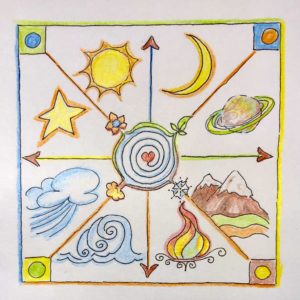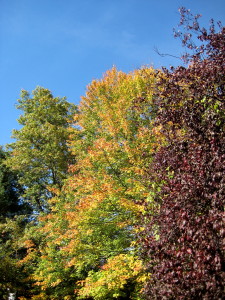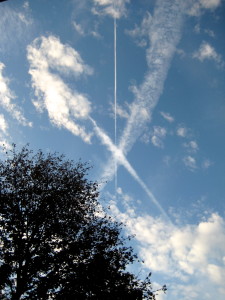
-Illustration © 2022 Jan Ketchel
Perfection is wholeness. Wholeness is the four-sided mandala: 4 directions, 4 seasons, 4 stages of life, etc. Winter is pregnancy. Spring is birth. Summer is fulfillment. Fall is death.
The decay of Fall provides the seeds and nourishment for new life, as the life cycle completes itself and begins anew. Nature teaches, in this most basic way, that life feeds upon life. The shamans of ancient Mexico called our world a predatory universe, not as a judgment but as nature’s destructive truth.
Evil is branded the demon, and it may present as such, but it is a necessary part of the life cycle, a fundamental part of our wholeness. Archetypes are the primal patterns that generate the life cycle. Archetypes populate the deepest level of the human unconscious, what Jung called the collective unconscious.
Joseph Campbell realized that in world mythology, which personifies the organizing influence of the archetypes upon human behavior, the hero archetype has a thousand faces. Local cultures thus dress the core archetypes in local clothing and masks, but beneath the surface all the different variations can be reduced to the same universal archetypes.
Despite the culture or religion, the hero is always sacrificed, changes form, and is born again into new life. Once again, nature’s fallen resurrects in the new life of Spring.
Archetypes insist on being propitiated. We must appease their energetic imperatives or suffer the agonizing consequences of their wrath. For example, depression is often the withdrawal of life energy by a neglected archetype. If we refuse a rite of Spring, like Daphne our life might harden into a frozen tree.
Modern humanity has forgotten its natural roots. The animal has been confined to the darkness of the basement, in the area of the psyche Jung called the shadow. While humanity luxuriates in its advanced technology, the animal in the shadow plans its escape into life. Here’s how Jung described the ravaged animal’s escape in Nazi Germany:
“Like the rest of the world, [the Germans] did not understand wherein Hitler‘s significance lay, that he symbolized something in every individual. He was the most prodigious personification of all human inferiorities. He was an utterly incapable, unadapted, irresponsible, psychopathic personality, full of empty, infantile fantasies, but cursed with the keen intuition of a rat or a guttersnipe. He represented the shadow, the inferior part of everybody‘s personality, in an overwhelming degree, and this was another reason why they fell for him.” *
Projection of one’s disowned self onto a political leader renders one the sacrificial victim of a wrathful archetype. Victimhood is experienced as both the ecstasy of the entranced and the rage and hate of the rationally disenchanted. In both cases one is drawn into emotional bondage by the archetype.
In either case, the truly disenfranchised is both the personal and collective shadow, the neglected animal and the natural world, the Earth. This is a universal collective problem for humankind, not simply an issue of polarization.
The archetype of the shadow is just that, that which lives in the darkness. This is both the truth of our disowned lives, as well as the archetype of our unlived wholeness. To propitiate the shadow, we must bring the light of our consciousness into the darkness and discover the fullness of who we are.
In waking life, our journeys into darkness require us to own and release the intensity of our emotions in a safe place. Beyond release is the full knowing and acceptance of all we have done, light and dark. Finally, the darkness will reveal the changes we must make to align ourselves with our wholeness.
If we can suffer the Fall, reveling in its final colorful act, and have the patience of a pregnant Winter, new life will surely arrive, to be nourished in the Spring and brought to fulfillment in Summer, as the life cycle perfects its wholeness.
Seeking perfection,
Chuck
*Jung, C. G. (1946). Fight with the Shadow. In The Collected Works of C.G. Jung (Vol. 10). Princeton: Princeton University Press.



